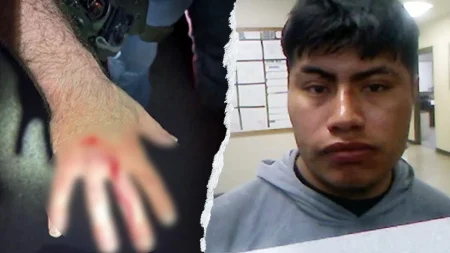MS-13 Gang Leader Deported After Attempting to Circumvent Immigration System
In a significant development for U.S. immigration enforcement, the Department of Homeland Security (DHS) announced the deportation of Wilmer Alexy Garcia-Manzanarez, an El Salvadorean MS-13 gang leader, to his home country. The deportation, which occurred on November 3, represents a shift in how the current administration is handling cases involving criminal immigrants with outstanding warrants in their home countries. Garcia-Manzanarez, who had been initially arrested by U.S. Immigration and Customs Enforcement (ICE) in February 2024, allegedly attempted to avoid deportation by claiming he feared returning to El Salvador, where he faced a murder warrant. This case highlights the complex challenges the immigration system faces when dealing with individuals who have criminal histories both in the United States and their countries of origin.
The journey of Garcia-Manzanarez through the U.S. immigration system spans over two decades and reveals persistent issues with border security and immigration enforcement. His first entry into the United States occurred in March 2001, when he illegally crossed the Canadian border and was apprehended by the U.S. Border Patrol. Despite being arrested, he was released into the country, only to be ordered removed by an immigration judge a year later. What followed was a pattern of deportations and illegal re-entries: between January 2007 and October 2012, ICE officers deported Garcia-Manzanarez to El Salvador three times, but he continued to return to the United States unlawfully. His most recent arrest took place in Foxboro, Massachusetts, in February 2024, after Interpol had issued a Red Notice for his apprehension in January 2020 related to the outstanding murder warrant in El Salvador.
During his time in the United States, Garcia-Manzanarez allegedly committed numerous crimes that ranged from burglary to driving under the influence. According to DHS statements, his criminal record includes menacing and intimidation with a weapon, property damage, and driving without a license. These offenses, combined with his MS-13 gang affiliation and the murder warrant in El Salvador, painted the picture of an individual who posed a significant public safety risk. DHS Assistant Secretary Tricia McLaughlin expressed frustration with how the case had been handled previously, stating, “The Biden administration let this MS-13 gang member and wanted murderer claim fear of returning to El Salvador despite having a final order of removal and three prior deportations. Of course, a wanted murderer does not want to return to his country to face justice for his crimes.”
The deportation of Garcia-Manzanarez comes amidst broader efforts to target criminal elements within immigrant communities. Recently, a raid in Charlotte targeting criminal immigrants resulted in approximately 130 arrests, including another MS-13 gang member. These operations reflect a heightened focus on removing individuals with serious criminal backgrounds who may pose threats to community safety. At the same time, law enforcement agencies have warned about scammers posing as ICE officials to extort immigrant communities, adding another layer of complexity to immigration enforcement efforts. This environment of intensified enforcement, legitimate and fraudulent, has created significant tension and fear in many immigrant communities across the country.
The case of Garcia-Manzanarez also illuminates the challenges and contradictions within the asylum system. While asylum is designed to protect individuals who face persecution in their home countries, questions arise when those seeking protection are themselves accused of serious crimes. The statement from DHS Assistant Secretary McLaughlin that “the days of the world’s criminals indefinitely remaining in our country are over” signals a potentially stricter approach to asylum claims from individuals with criminal histories. This stance raises important questions about the balance between humanitarian protections and public safety concerns, as well as the role of international cooperation in addressing transnational crime and migration.
Looking forward, this case may represent a turning point in how immigration authorities approach similar situations involving criminal deportees with outstanding warrants in their home countries. The emphasis placed on this deportation by current DHS leadership suggests that stricter enforcement against criminal immigrants will be a priority. However, the complex realities of immigration, including the push factors that drive migration, the limitations of border enforcement, and the humanitarian obligations of the United States, remain challenging issues that will continue to shape immigration policy debates. As enforcement strategies evolve, finding the balance between security concerns and fair, humane treatment of all immigrants will remain a central challenge for policymakers and immigration authorities alike.










